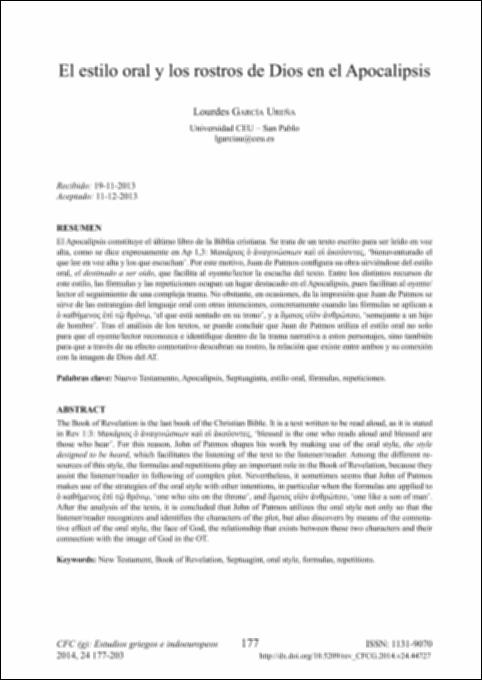Por favor, use este identificador para citar o enlazar este ítem:
http://hdl.handle.net/10637/11873El estilo oral y los rostros de Dios en el Apocalípsis.
| Título : | El estilo oral y los rostros de Dios en el Apocalípsis. New Testament |
| Autor : | García Ureña, Lourdes |
| Materias: | Apocalípsis; Nuevo Testamento; Septuaginta; Estilo oral; Fórmulas; Repeticiones; Book of Revelation; Septuagint; Oral style; Repetitions |
| Resumen : | El Apocalipsis constituye el último libro de la Biblia cristiana. Se trata de un texto escrito para ser leído en voz
alta, como se dice expresamente en Ap 1,3: Μακάριος ὁ ἀναγινώσκων καὶ οἱ ἀκούοντες, ‘bienaventurado el
que lee en voz alta y los que escuchan’. Por este motivo, Juan de Patmos confi gura su obra sirviéndose del estilo
oral, el destinado a ser oído, que facilita al oyente/lector la escucha del texto. Entre los distintos recursos de
este estilo, las fórmulas y las repeticiones ocupan un lugar destacado en el Apocalipsis, pues facilitan al oyente/
lector el seguimiento de una compleja trama. No obstante, en ocasiones, da la impresión que Juan de Patmos se
sirve de las estrategias del lenguaje oral con otras intenciones, concretamente cuando las fórmulas se aplican a
ὁ καθήμενος ἐπὶ τῷ θρόνῳ, ‘el que está sentado en su trono’, y a ὅμοιος υἱὸν ἀνθρώπου, ‘semejante a un hijo
de hombre’. Tras el análisis de los textos, se puede concluir que Juan de Patmos utiliza el estilo oral no solo
para que el oyente/lector reconozca e identifi que dentro de la trama narrativa a estos personajes, sino también
para que a través de su efecto connotativo descubran su rostro, la relación que existe entre ambos y su conexión
con la imagen de Dios del AT. The Book of Revelation is the last book of the Christian Bible. It is a text written to be read aloud, as it is stated in Rev 1:3: Μακάριος ὁ ἀναγινώσκων καὶ οἱ ἀκούοντες, ‘blessed is the one who reads aloud and blessed are those who hear’. For this reason, John of Patmos shapes his work by making use of the oral style, the style designed to be heard, which facilitates the listening of the text to the listener/reader. Among the different resources of this style, the formulas and repetitions play an important role in the Book of Revelation, because they assist the listener/reader in following of complex plot. Nevertheless, it sometimes seems that John of Patmos makes use of the strategies of the oral style with other intentions, in particular when the formulas are applied to ὁ καθήμενος ἐπὶ τῷ θρόνῳ, ‘one who sits on the throne’, and ὅμοιος υἱὸν ἀνθρώπου, ‘one like a son of man’. After the analysis of the texts, it is concluded that John of Patmos utilizes the oral style not only so that the listener/reader recognizes and identifi es the characters of the plot, but also discovers by means of the connotative effect of the oral style, the face of God, the relationship that exists between these two characters and their connection with the image of God in the OT. |
| Descripción : | En: Estudios griegos e indoeuropeos. ISSN 1131-9070. 2014. vol. 24, 177-203 pp |
| URI : | http://hdl.handle.net/10637/11873 |
| Derechos: | http://creativecommons.org/licenses/by-nc-nd/4.0/deed.es |
| Fecha de publicación : | 11-dic-2010 |
| Centro : | Universidad San Pablo-CEU |
| Aparece en las colecciones: | Facultad de Humanidades y CC de la Comunicación |
Los ítems de DSpace están protegidos por copyright, con todos los derechos reservados, a menos que se indique lo contrario.


